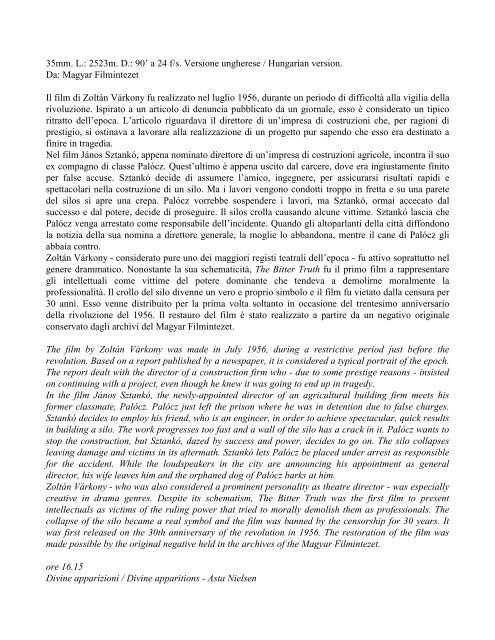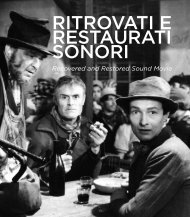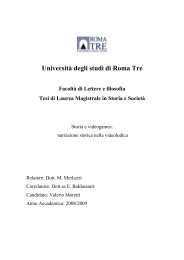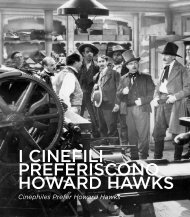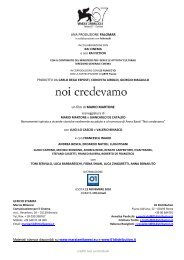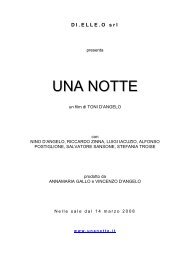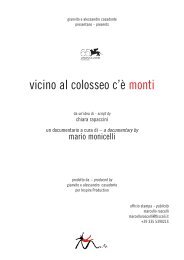Catalogo 1999 - Cineteca di Bologna
Catalogo 1999 - Cineteca di Bologna
Catalogo 1999 - Cineteca di Bologna
Create successful ePaper yourself
Turn your PDF publications into a flip-book with our unique Google optimized e-Paper software.
35mm. L.: 2523m. D.: 90’ a 24 f/s. Versione ungherese / Hungarian version.<br />
Da: Magyar Filmintezet<br />
Il film <strong>di</strong> Zoltán Várkony fu realizzato nel luglio 1956, durante un periodo <strong>di</strong> <strong>di</strong>fficoltà alla vigilia della<br />
rivoluzione. Ispirato a un articolo <strong>di</strong> denuncia pubblicato da un giornale, esso è considerato un tipico<br />
ritratto dell’epoca. L’articolo riguardava il <strong>di</strong>rettore <strong>di</strong> un’impresa <strong>di</strong> costruzioni che, per ragioni <strong>di</strong><br />
prestigio, si ostinava a lavorare alla realizzazione <strong>di</strong> un progetto pur sapendo che esso era destinato a<br />
finire in trage<strong>di</strong>a.<br />
Nel film János Sztankó, appena nominato <strong>di</strong>rettore <strong>di</strong> un’impresa <strong>di</strong> costruzioni agricole, incontra il suo<br />
ex compagno <strong>di</strong> classe Palócz. Quest’ultimo è appena uscito dal carcere, dove era ingiustamente finito<br />
per false accuse. Sztankó decide <strong>di</strong> assumere l’amico, ingegnere, per assicurarsi risultati rapi<strong>di</strong> e<br />
spettacolari nella costruzione <strong>di</strong> un silo. Ma i lavori vengono condotti troppo in fretta e su una parete<br />
del silos si apre una crepa. Palócz vorrebbe sospendere i lavori, ma Sztankó, ormai accecato dal<br />
successo e dal potere, decide <strong>di</strong> proseguire. Il silos crolla causando alcune vittime. Sztankó lascia che<br />
Palócz venga arrestato come responsabile dell’incidente. Quando gli altoparlanti della città <strong>di</strong>ffondono<br />
la notizia della sua nomina a <strong>di</strong>rettore generale, la moglie lo abbandona, mentre il cane <strong>di</strong> Palócz gli<br />
abbaia contro.<br />
Zoltán Várkony - considerato pure uno dei maggiori registi teatrali dell’epoca - fu attivo soprattutto nel<br />
genere drammatico. Nonostante la sua schematicità, The Bitter Truth fu il primo film a rappresentare<br />
gli intellettuali come vittime del potere dominante che tendeva a demolirne moralmente la<br />
professionalità. Il crollo del silo <strong>di</strong>venne un vero e proprio simbolo e il film fu vietato dalla censura per<br />
30 anni. Esso venne <strong>di</strong>stribuito per la prima volta soltanto in occasione del trentesimo anniversario<br />
della rivoluzione del 1956. Il restauro del film è stato realizzato a partire da un negativo originale<br />
conservato dagli archivi del Magyar Filmintezet.<br />
The film by Zoltán Várkony was made in July 1956, during a restrictive period just before the<br />
revolution. Based on a report published by a newspaper, it is considered a typical portrait of the epoch.<br />
The report dealt with the <strong>di</strong>rector of a construction firm who - due to some prestige reasons - insisted<br />
on continuing with a project, even though he knew it was going to end up in tragedy.<br />
In the film János Sztankó, the newly-appointed <strong>di</strong>rector of an agricultural buil<strong>di</strong>ng firm meets his<br />
former classmate, Palócz. Palócz just left the prison where he was in detention due to false charges.<br />
Sztankó decides to employ his friend, who is an engineer, in order to achieve spectacular, quick results<br />
in buil<strong>di</strong>ng a silo. The work progresses too fast and a wall of the silo has a crack in it. Palócz wants to<br />
stop the construction, but Sztankó, dazed by success and power, decides to go on. The silo collapses<br />
leaving damage and victims in its aftermath. Sztankó lets Palócz be placed under arrest as responsible<br />
for the accident. While the loudspeakers in the city are announcing his appointment as general<br />
<strong>di</strong>rector, his wife leaves him and the orphaned dog of Palócz barks at him.<br />
Zoltán Várkony - who was also considered a prominent personality as theatre <strong>di</strong>rector - was especially<br />
creative in drama genres. Despite its schematism, The Bitter Truth was the first film to present<br />
intellectuals as victims of the ruling power that tried to morally demolish them as professionals. The<br />
collapse of the silo became a real symbol and the film was banned by the censorship for 30 years. It<br />
was first released on the 30th anniversary of the revolution in 1956. The restoration of the film was<br />
made possible by the original negative held in the archives of the Magyar Filmintezet.<br />
ore 16.15<br />
Divine apparizioni / Divine apparitions - Asta Nielsen


